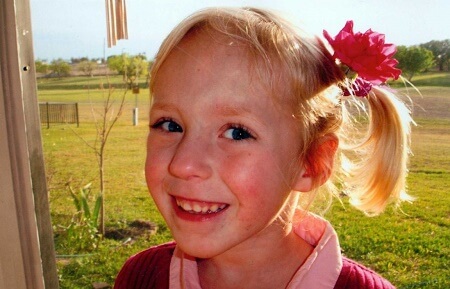
If you didn’t read your friendly neighborhood newspaper in 2019, you missed out on some incredible investigative journalism.
Last year the Houston Chronicle published watchdog stories about Child Protective Services unfairly taking children away from families; stories about how Texas is shortchanging students; and stories about a sexual abuse crisis in the Southern Baptist Convention, the second largest faith group in the United States behind the Catholic Church.
The list goes on. In fact, I went ahead and made a list of some of the Chronicle’s best stories in 2019. Because while lots of people still religiously read their local paper, it’s also depressingly easy to find people who don’t see the point.
The past decade has been tough on the newspaper industry. Reading habits have changed. Facebook offers a free and never-ending stream of (mis)information. Who needs an ink-stained relic from the coal age for news?
The thing is, that ink-stained relic still boasts the largest newsroom in its community. Nothing else in the media landscape even comes close. Metro newspapers still field a small army of reporters to dig up stories, editors to help keep them on track, photographers to capture compelling moments, graphic designers to make the complex easily understandable, data journalists to crunch numbers and build interactive online graphics, and web and page designers to invite readers along for the ride.
Newspapers have ample time and resources to tell you something new about the world. Sometimes these stories make the world a better place by exposing problems. Stories in the Houston Chronicle have helped protect children from sexual predators, held public officials accountable, and triggered legislative scrutiny.
I’m old enough to remember when reporters didn’t have to worry about the business side of the news business. We didn’t have to worry about telling people why it’s important to subscribe. We let our work speak for ourselves.
Times have changed.
Regional newspapers across the country are still diligently serving as watchdogs in their communities. The exercise of compiling these big stories drives home the point that there’s a lot of good stuff to read in your friendly neighborhood newspaper. The Detroit Free Press published an entire special section devoted to the impact of its journalism. It’s a great idea.
Before you point out one of the many examples out there of a newspaper falling short of its mission, let me save you some time. You’re right. Newspapers have many faults.
But even with many faults, newspapers are still worth reading.
Still skeptical? Check out some of my favorite investigative stories that ran in the Chronicle in 2019:
Abuse of Faith
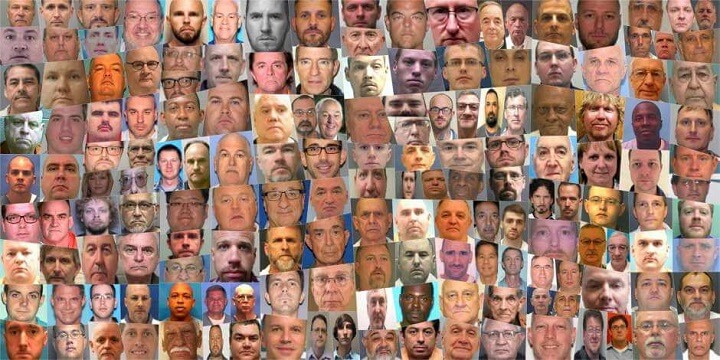
Nearly two years ago, Chronicle reporter Robert Downen covered a lawsuit against former state Judge Paul Pressler, a prominent figure in the Southern Baptist Convention who had been accused in civil papers of sexual abuse. During the course of that reporting, Downen came across other cases of sexual abuse involving Baptist leaders. He started building a spreadsheet to keep track of all the cases he found. It grew steadily by the day.
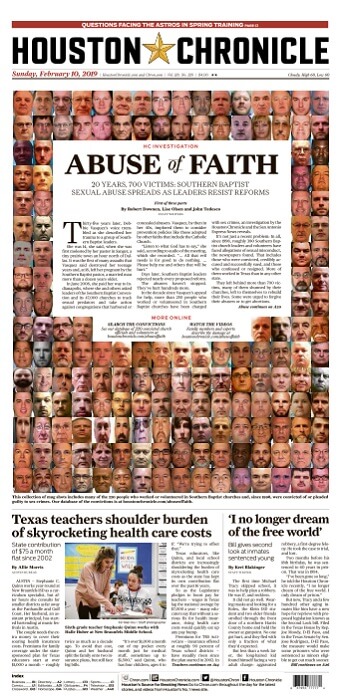 Countless stories have been written about the sexual abuse crisis in the Catholic Church. But there had rarely been any big investigations of the Southern Baptist Convention, which has 47,000 churches across the United States.
Countless stories have been written about the sexual abuse crisis in the Catholic Church. But there had rarely been any big investigations of the Southern Baptist Convention, which has 47,000 churches across the United States.
Steve Riley, the Chronicle’s investigations editor at the time who is now executive editor, asked me and investigative reporter Lise Olsen to help Rob find out how often sexual abuse happens at Southern Baptist churches, and what’s being done to stop it.
Photo journalist Jon Shapley was often by our side wherever we traveled, shooting photos and videos. Our spreadsheet of Baptist offenders came to life with the help of data journalists Jordan Rubio and Matt Dempsey, who checked our work and built an online database that readers could use as a public resource. Steve kept pushing us forward with weekly meetings and marching orders.
The result, after months of reporting, was Abuse of Faith, a multipart series the Chronicle published with the San Antonio Express-News that revealed how hundreds of church ministers, employees and volunteers had sexually abused more than 700 people over the past 20 years. Most of the victims were children.
The response was staggering. National media outlets picked up the stories. Hundreds of readers contacted us, many with their own stories of abuse. Baptist leaders said they were “broken” by the findings and promised to protect the vulnerable. The series changed the conversation of the SBC’s annual meeting in Birmingham last year, where Baptist leaders urged pastors to take the issue seriously and to adopt measures to prevent abuse.
As tips and responses from readers poured in, the Chronicle continued to publish more stories. Sarah Smith, who covered sexual abuses in independent Baptist churches, joined the team and helped reveal how Southern Baptist missionaries have suffered few, if any, repercussions when they sexually abused people while serving abroad.
Russell Moore, president of the SBC’s Ethics and Religious Liberty Commission, praised the newspapers’ investigation and said people with “functioning consciences” have been “filled with rage” by the findings.
“The idea that somehow this shouldn’t be out there in public is exactly the mentality that leads to these predators being able to carry out their actions,” Moore said.
Broken Trust
Less than a month after the Chronicle published Abuse of Faith, the paper unveiled the findings of yet another investigation that was a year in the making. Broken Trust, by Susan Carroll and David Hunn, untangled the complicated purse strings of the Texas Permanent School Fund, a $44 billion piggy bank for school children. Faced with a mind-numbing financial story, Susan and David clearly explained to readers what was wrong with the fund and why people should care:
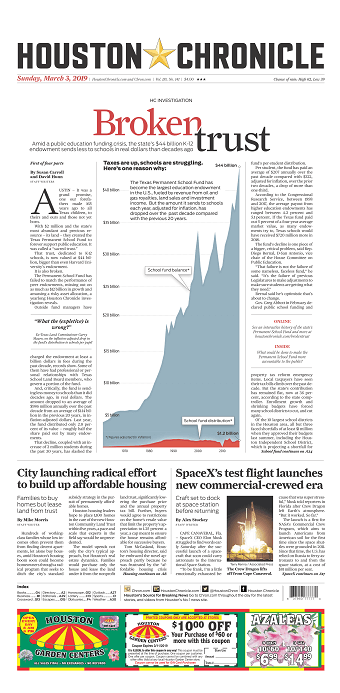
It was a grand promise, one our forefathers made 165 years ago to all Texas children, to theirs and ours and those not yet born.
With $2 million and the state’s most abundant and precious resource — its land — they created the Texas Permanent School Fund to forever support public education. It was called a “sacred trust.”
That trust, dedicated to K-12 schools, is now valued at $44 billion, bigger than even Harvard University’s endowment.
It is also broken.
The Permanent School Fund has failed to match the performance of peer endowments, missing out on as much as $12 billion in growth and amassing a risky asset allocation, a yearlong Houston Chronicle investigation reveals.
Outside fund managers have charged the endowment at least a billion dollars in fees during the past decade, records show. Some of them have had professional or personal relationships with Texas School Land Board members, who govern a portion of the fund.
And, critically, the fund is sending less money to schools than it did decades ago, in real dollars. The amount dropped to an average of $986 million annually over the past decade from an average of $1.14 billion in the previous 20 years, in inflation-adjusted dollars. Last year, the fund distributed only 2.8 percent of its value — roughly half the share paid out by many endowments.
Do No Harm
Mike Hixenbaugh, a former Chronicle reporter who now works at NBC News, and Keri Blakinger, who was just hired by the Marshall Project, spent nine months investigating doctors who specialize in providing expert testimony in suspected cases of child abuse in Texas. The project started after Keri covered a case of Child Protective Services wrongfully taking children away from their parents. Keri and Mike started investigating.
Their series, Do No Harm, has raised concerns among Texas lawmakers:

Unbeknownst to many parents who encounter them, these pediatricians, now stationed at virtually every major children’s hospital in the country, work closely with child welfare agencies and law enforcement, providing expert reports and court testimony in thousands of cases a year and helping to shield untold numbers of abused children from additional harm.
But in their zeal to protect children, some child abuse pediatricians also have implicated parents who appear to have credible claims of innocence, leading to traumatic family separations and questionable criminal charges, an investigation by the Houston Chronicle and NBC News has found.
Even critics acknowledge that the doctors’ conclusions are likely correct most of the time, particularly in cases where children have suffered extensive unexplained injuries. But when the evidence is less clear, a diagnosis of child abuse can devastate families, often with long-term consequences.
Reporters for this series spent nine months examining more than 40 such cases in Texas, a state that provides $5 million in grants each year — including $2.5 million from the agency that oversees Child Protective Services — to support the work of these physicians, deputizing them to review cases on behalf of child welfare investigators. Reporters scrutinized thousands of pages of court transcripts, government contracts and medical records. They spoke with more than 75 attorneys and doctors, and interviewed two dozen current and former Child Protective Services employees and union officials.
The reporting reveals a legal and medical system that sometimes struggles to differentiate accidental injuries from abuse, particularly in cases involving children too young to describe what happened to them. Physicians intent on protecting the most vulnerable in some instances have overstated the reliability of their findings, using terms such as “100 percent” and “certain” to describe conclusions that usually cannot be proven with absolute confidence. Child welfare workers, overworked and untrained in complex medical issues, are not always sure how to proceed when the primary evidence against a caregiver comes in the form of a doctor’s note.
A botched drug raid
Sometimes a newspaper publishes the findings of an investigation on a rolling basis as it learns more and more new information. For nearly a year, the Chronicle has published dozens of stories trying to get to the truth behind a botched drug raid by the Houston Police Department that killed Rhogena Nicholas and Dennis Tuttle and injured five officers.
Related: How to contact an investigative journalist
A team of Chronicle reporters covered the shootout and the aftermath. St. John Barned-Smith and Keri Blakinger learned that an internal police investigation concluded that Officer Gerald Goines had lied about using a confidential informant to buy heroin at the home of Nicholas and Tuttle. Police chief Art Acevedo ordered an “extensive audit” of the 175-member narcotics division and an examination of Goines’ recent cases.
The Chronicle did its own digging:
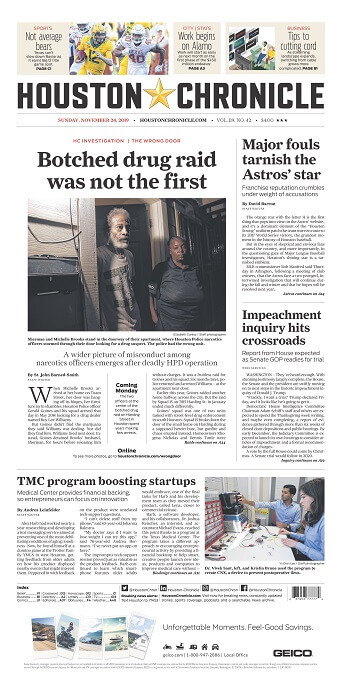
HPD Chief Art Acevedo maintains the problems with the operation and deaths of Tuttle and Nicholas were the work of a pair of rogue officers.
“I don’t have any indication it’s a pattern and practice,” Acevedo said after the raid.
However, a Houston Chronicle review of police records reveals a fuller picture of misconduct by Goines and past problems in the narcotics division.
Officers filed false affidavits when they asked judges for search warrants or arrest warrants. They performed sloppy investigative work and misrepresented their use of confidential informants, according to disciplinary records and court documents.
The Chronicle’s review also raises questions about the oversight of the division. While experts say best practices call for officers to rotate out of units such as narcotics regularly, dozens of officers have spent 10 years or more in that division at HPD. HPD’s inspections division audited narcotics’ operations just once in the 20 years prior to the deadly Jan. 28 raid, according to information obtained through a public records request.
The Track
When government officials took the unusual step of suing prostitutes, pimps and johns who congregated on the Bissonnet Track, legal affairs reporter Gabrielle Banks and photographer Godofredo Vasquez took the unusual step of visiting “the Track” again and again over the course of eight months to put a human face to the problem.
“The first few visits to the neighborhood startled us both,” Gabby wrote about the project. “We’re both big city kids, we’ve both reported in an array of difficult settings, but the near-omnipresence of street hustling at night caught us by surprise.”
Here’s how she started her three-part story:
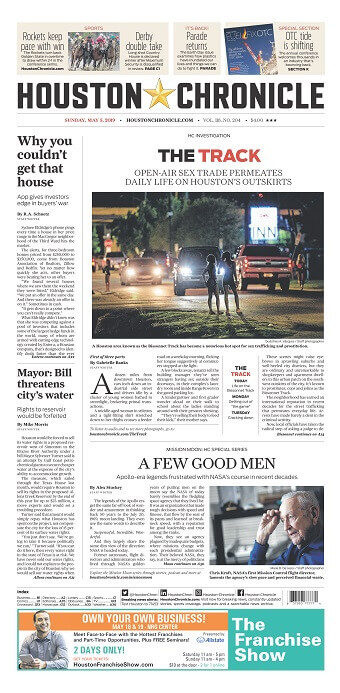
A dozen miles from downtown Houston, cars inch down an industrial side street and drivers idle by a cluster of young women bathed in streetlight, brokering primal transactions.
A middle-aged woman in stilettos and a tight-fitting shirt stretched down to her thighs crosses a feeder road on a weekday morning, flicking her tongue suggestively at commuters stopped at the light.
A few blocks away, tenants tell the building manager they’ve seen strangers having sex outside their doorways, in their complex’s laundry room and inside Range Rovers in the gated parking lot.
A kindergartner and first grader wonder aloud on their walk to school about the ladies standing around with their privates showing.
“They’re selling their body to feed their kids,” their mother says.
These scenes might raise eyebrows in sprawling suburbs and well-heeled city districts, but they are ordinary and unremarkable to shopkeepers and apartment dwellers in this urban patch on the southwest outskirts of the city. It’s known to prostitutes, cops and johns as the Bissonnet Track.
The neighborhood has earned an international reputation in recent decades for the street trafficking that permeates everyday life. Arrests have made barely a dent in the criminal activity.
Now, local officials have taken the radical step of asking a judge to declare several blocks off-limits to more than 80 people accused of engaging in prostitution — labeling them nuisances to the community and threatening fines if they return.
Denied Again
Three years ago, the Houston Chronicle revealed how Texas officials had arbitrarily denied thousands of school children access to special education services. The U.S. Department of Education ordered Texas to fix its broken system, saying the state was violating federal laws requiring schools to serve all students with disabilities.
Last year, education writer Shelby Webb and I teamed up with Laura Isensee at Houston Public Media to see how Texas has responded:
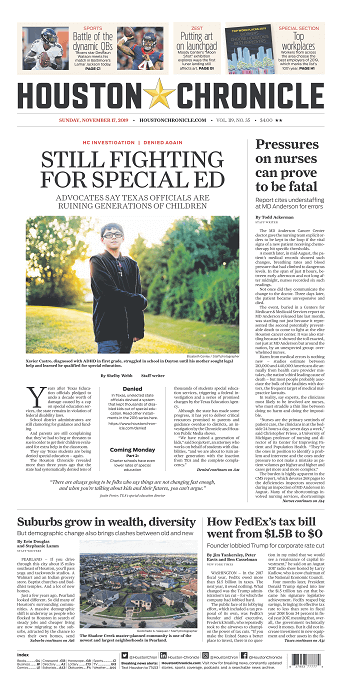
Years after Texas Education officials pledged to undo a decade worth of damage caused by a cap on special education services, the state remains in violation of federal disability laws.
School district administrators are still clamoring for guidance and funding.
And parents are still complaining that they’ve had to beg or threaten to sue in order to get their children evaluated for extra help in the classroom.
They say Texas students are being denied special education — again.
The Houston Chronicle revealed more than three years ago that the state had systematically denied tens of thousands of students special education services, triggering a federal investigation and a series of promised changes by the Texas Education Agency.
Although the state has made some progress, it has yet to deliver critical resources promised to parents and guidance overdue to districts, an investigation by the Chronicle and Houston Public Media shows.
“We have ruined a generation of kids,” said Sonja Kerr, an attorney who works on behalf of students with disabilities, “and we are about to ruin another generation with the inaction from TEA and the complete complacency.”
Covering the beat
Newspapers spend a lot of time and money on lengthy investigations. Those stories are important. But in between the big hits are stories from reporters who cover specific beats — things like City Hall and the transportation beat. If you spend any time reading the Chronicle, you can tell its beat reporters aren’t sitting around covering meetings, waiting to be spoon fed stories.
No reporter in Texas has done more to decipher the arcane billing practices of the health care industry than Jenny Deam. She’s saved customers hundreds of thousands of dollars by writing about their battles with insurance companies. Her last story of 2019 was about yet another firm — Companion Life Insurance — that reversed course and decided to pay for a patient’s mounting medical bills after Jenny wrote about the dispute.
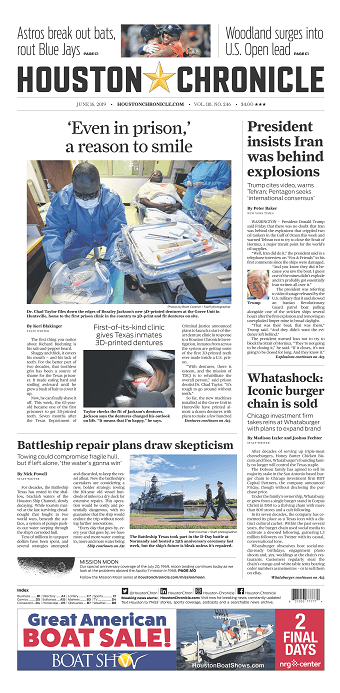 It’s hard to pinpoint Keri Blakinger’s best story about the state’s criminal justice system. But last year, she witnessed the launch of a state-of-the art denture clinic for prison inmates. Oh yeah, Keri was the one who revealed how Texas prisons rarely provided dentures to inmates.
It’s hard to pinpoint Keri Blakinger’s best story about the state’s criminal justice system. But last year, she witnessed the launch of a state-of-the art denture clinic for prison inmates. Oh yeah, Keri was the one who revealed how Texas prisons rarely provided dentures to inmates.
City Hall reporter Mike Morris’ latest story in 2019 revealed how no one is keeping track of who attends games and events at government-run suites at Minute Maid Park, Toyota Center and NRG Stadium. Mike’s covered the region’s sluggish disaster response to Hurricane Harvey. He helped analyze campaign contributions from city vendors to Mayor Sylvester Turner. And he teamed up with transportation reporter Dug Begley for this interesting, well-researched story about why Houston’s roads are in such terrible shape.
Zach Despart examined the unusual conflicts of interest between the district attorney’s office and its consultant, Amir Mireskandari, a Democratic booster with ties to poker clubs that were under criminal investigation. The cases were dropped when the conflicts came to light. Zach talked to just about everyone involved in the mess, including Mireskandari.
Alex Stuckey wrote enough stories in 2019 to fill a book about NASA’s mission to land on the moon. But the story that stood out to me was one I had never read before until she wrote it — the environmental impact of NASA’s rocket launches. Alex discovered there’s an astonishing lack of research about the problem.
Shelby Webb and Nick Powell wrote about the aftermath of the Sante Fe High School shooting, and how families of victims are still searching for answers to basic questions that Texas authorities refuse to provide. Were there red flags missed? Mistakes made? Who knows. Meanwhile, in Florida, officials have not only provided answers in the Parkland shooting, but there have been suspensions and firings. “The glaring differences in information and accountability for two similar mass shootings boil down to one factor: public records laws.” Shelby and Nick wrote.
Jacob Carpenter has continually mined the education beat for interesting stories. He recently obtained data from the Houston Independent School District to reveal how thousands of students have never checked out a library book. “The paltry checkout rates are indicative of HISD’s relatively low investment in library services, which has drawn criticism for more than a decade from librarians, literacy advocates and some district leaders,” Jacob wrote. He told me he got the story idea by “reading long ass reports that no one else is reading.”
In other words, doing the grunt work newspaper reporters do every day.
I can’t say what the Chronicle will look like in the next decade. But I think this relic will stay just as relevant as it was in the last decade.
